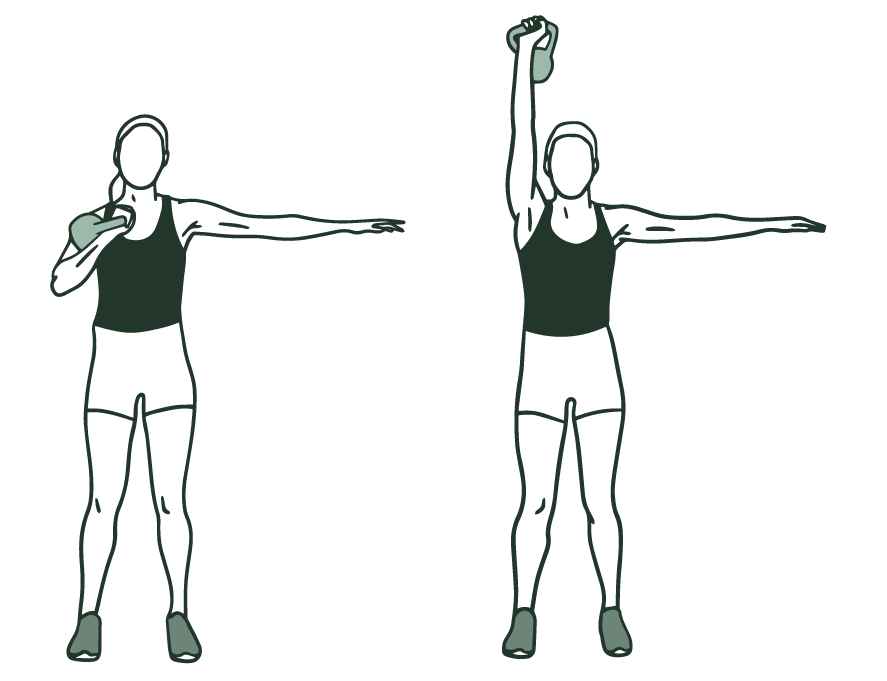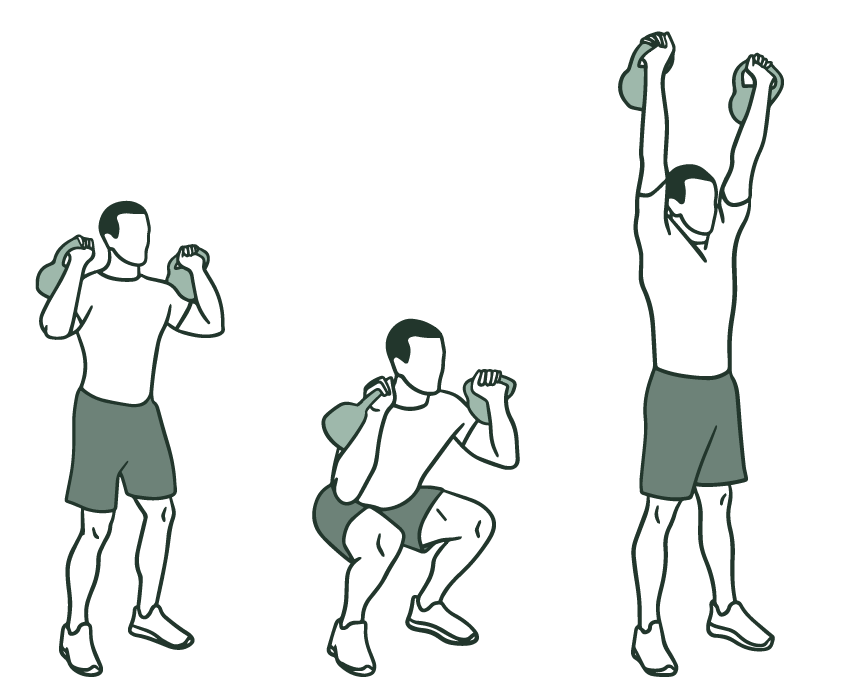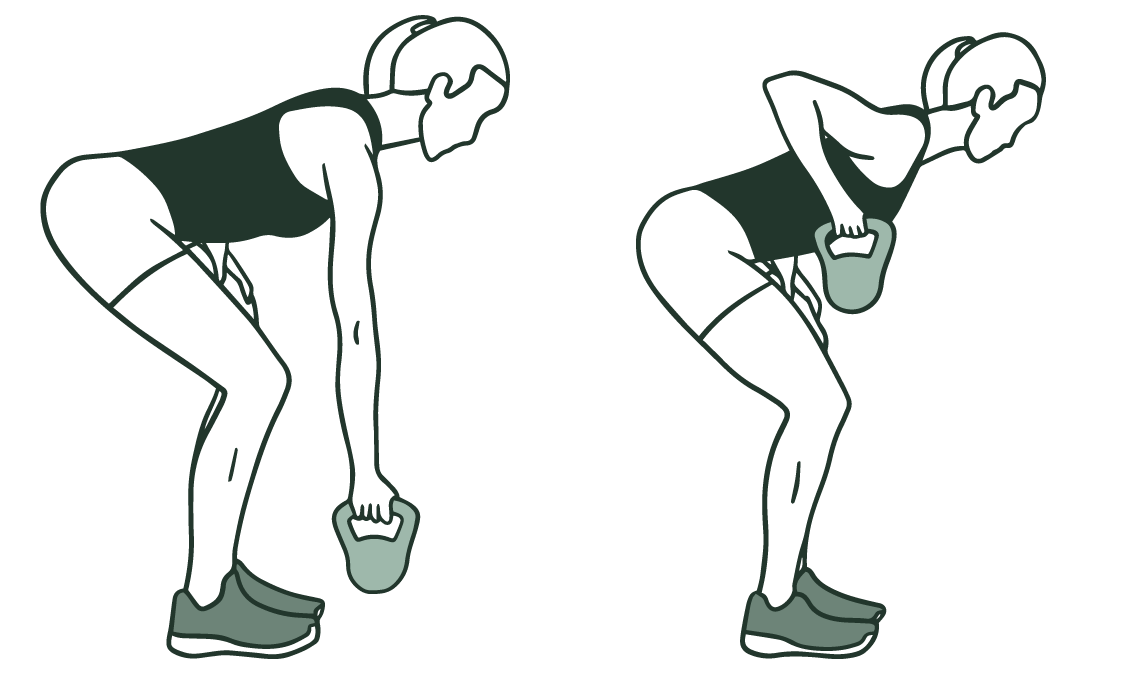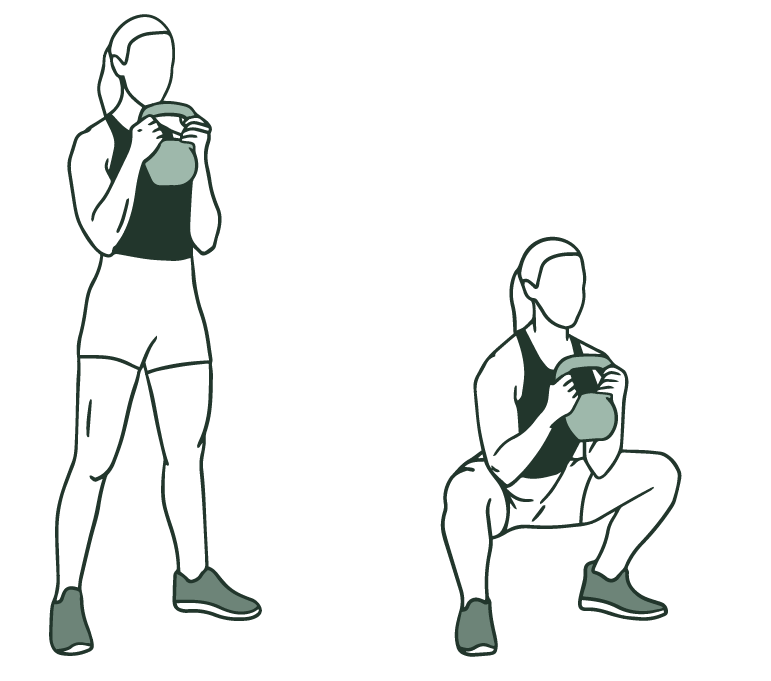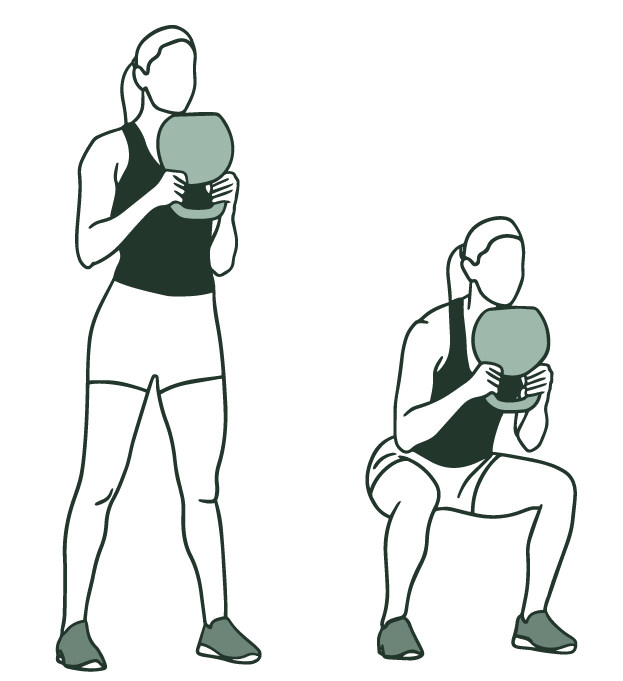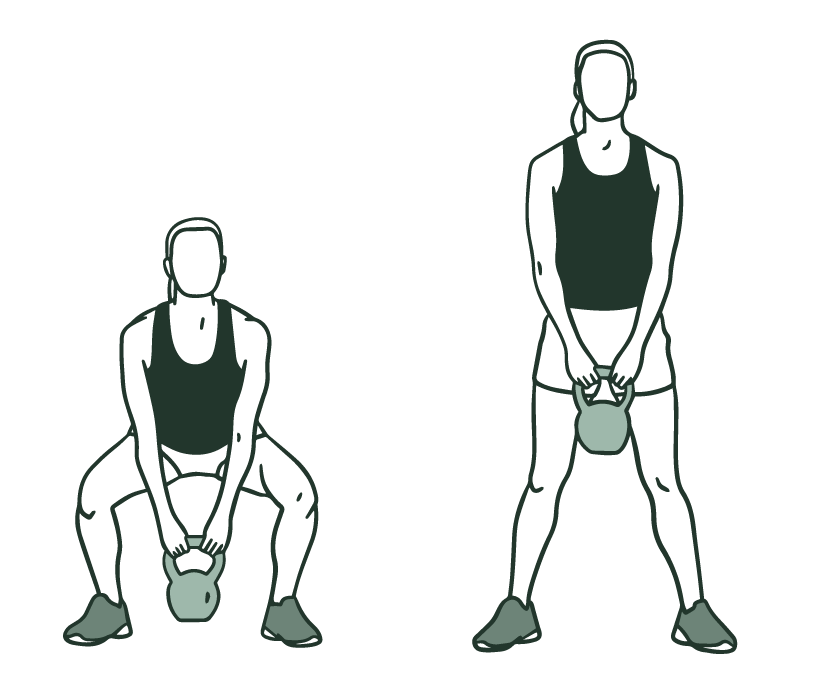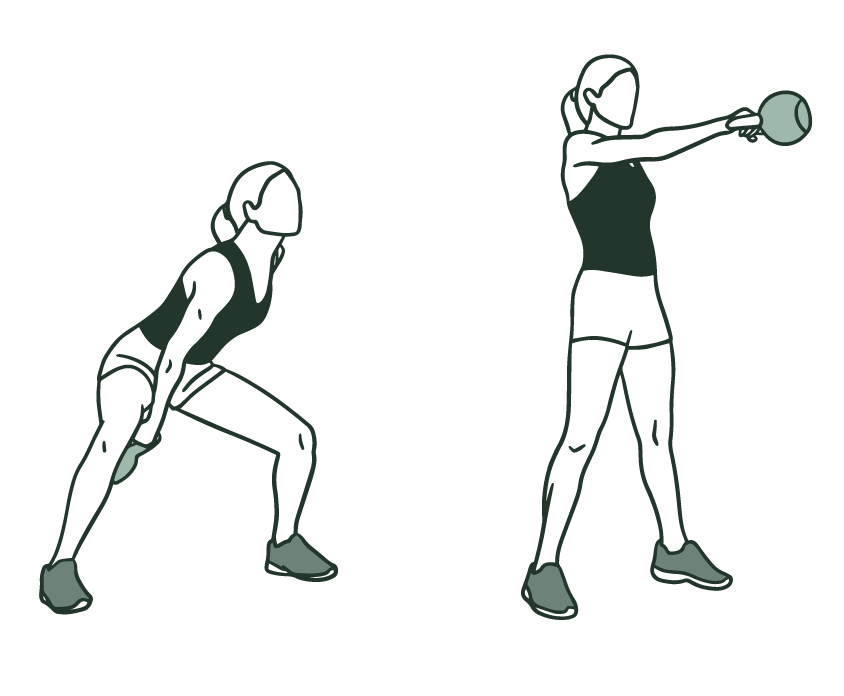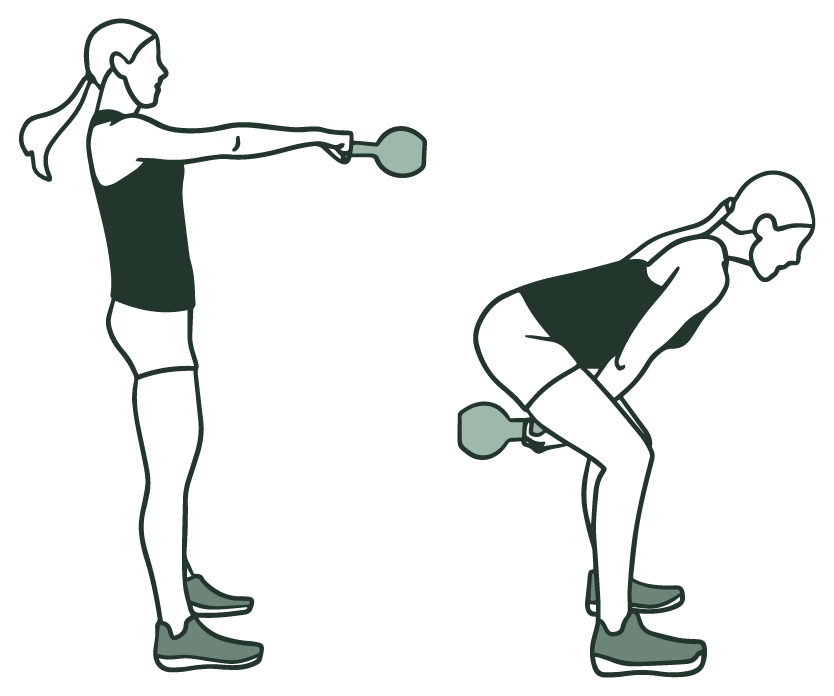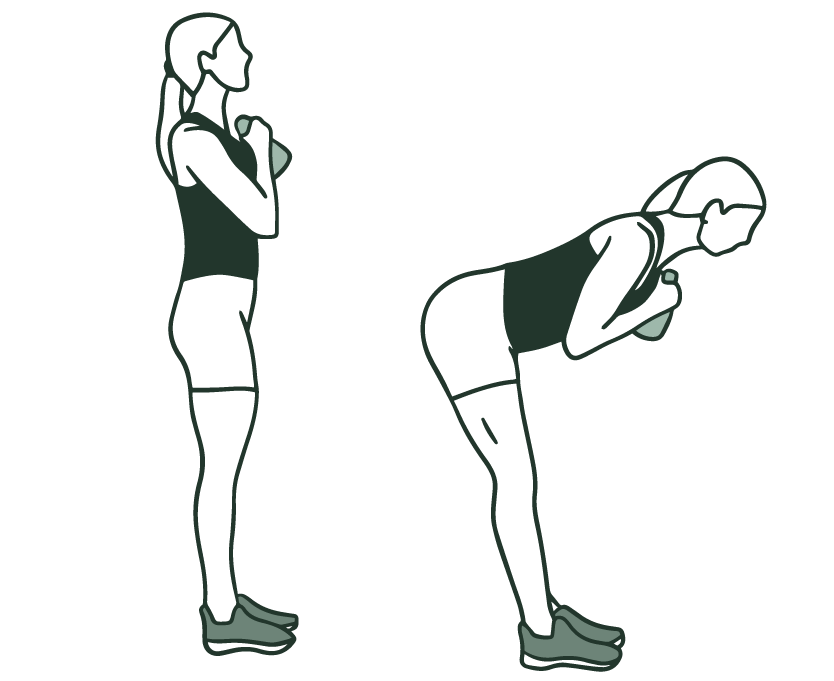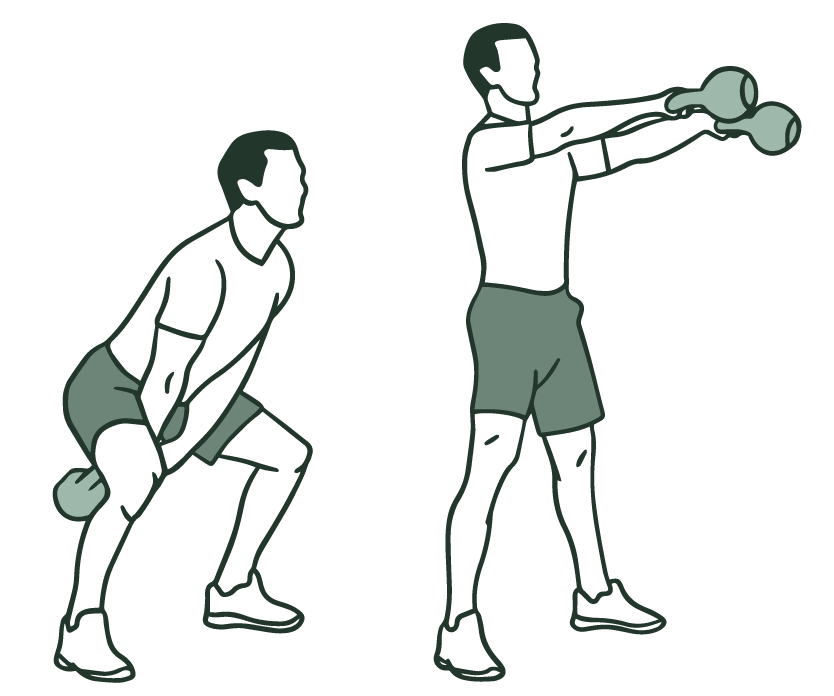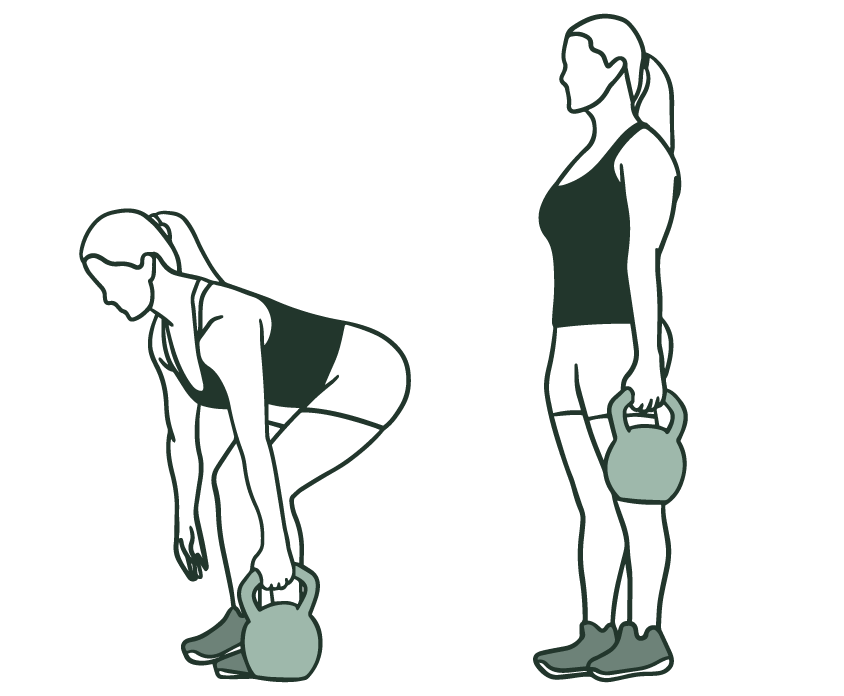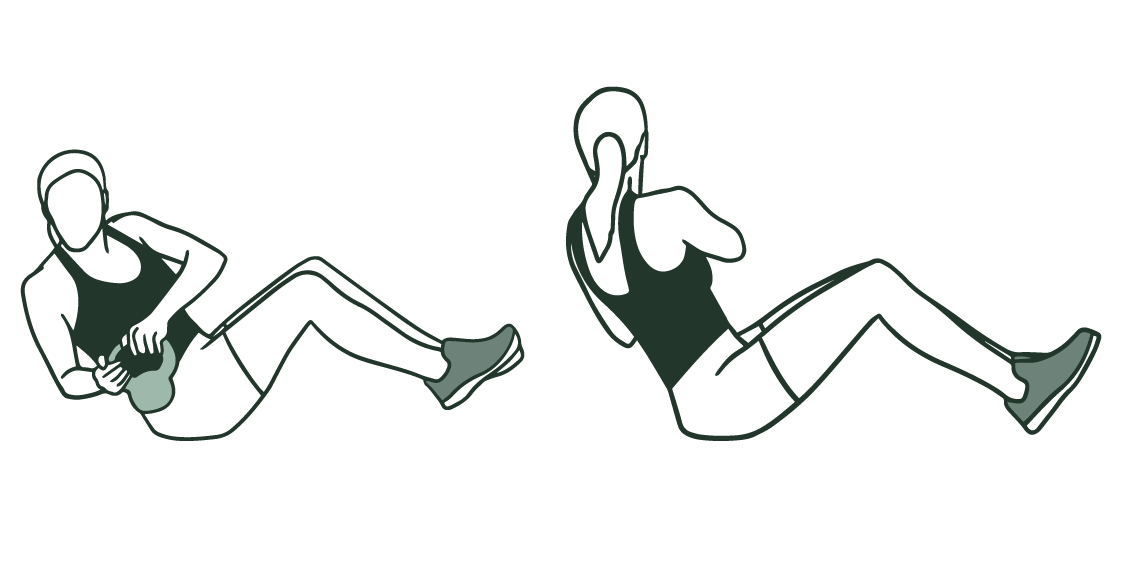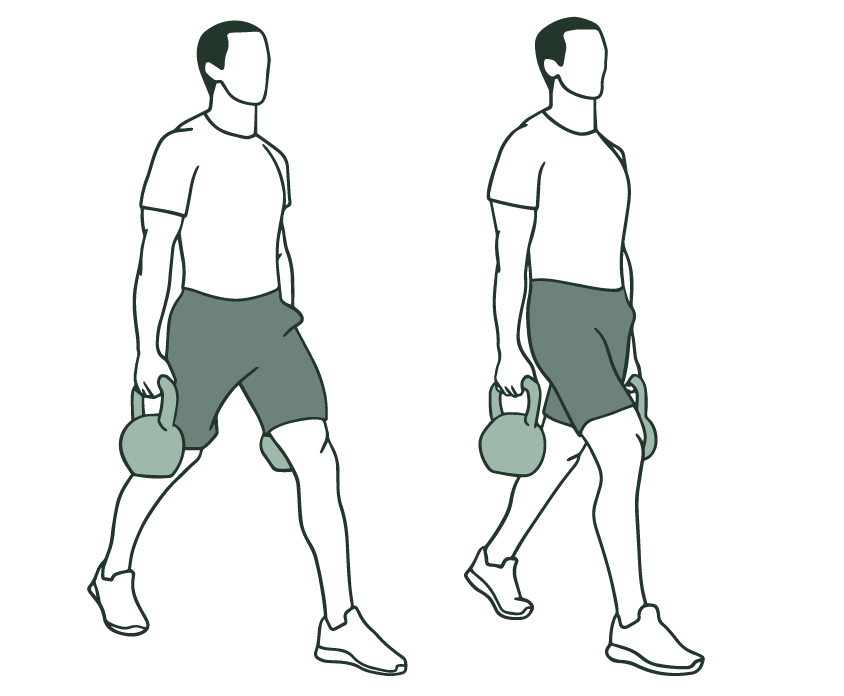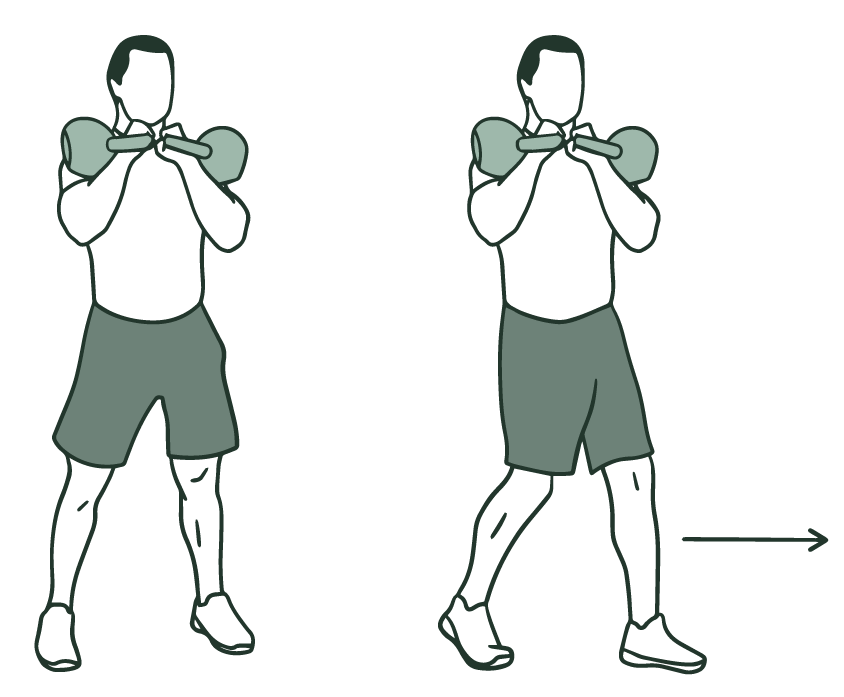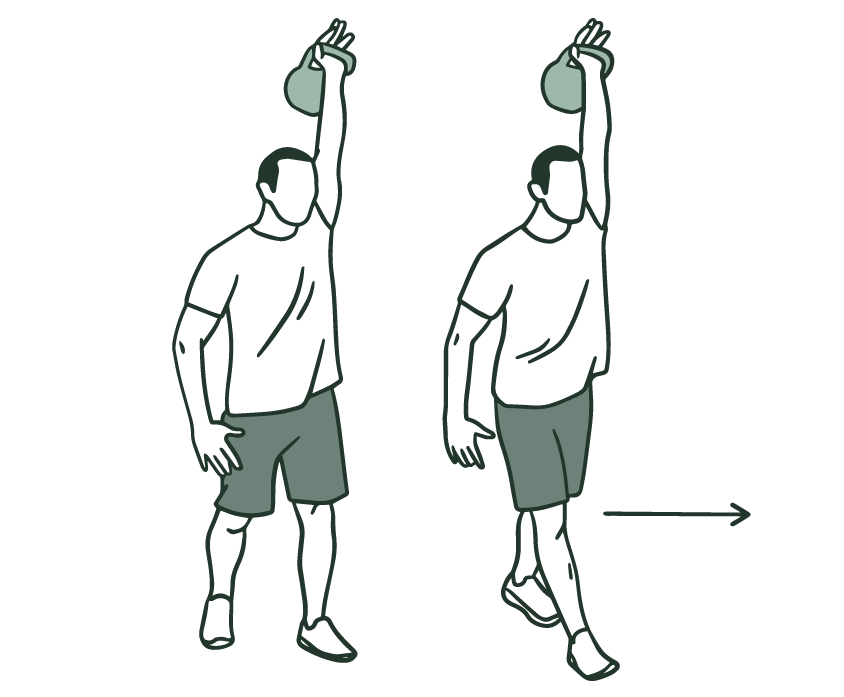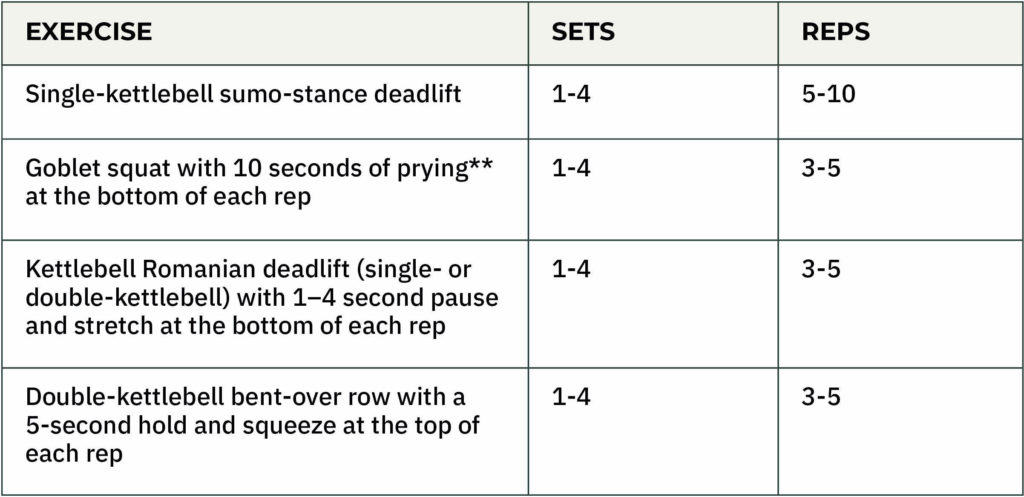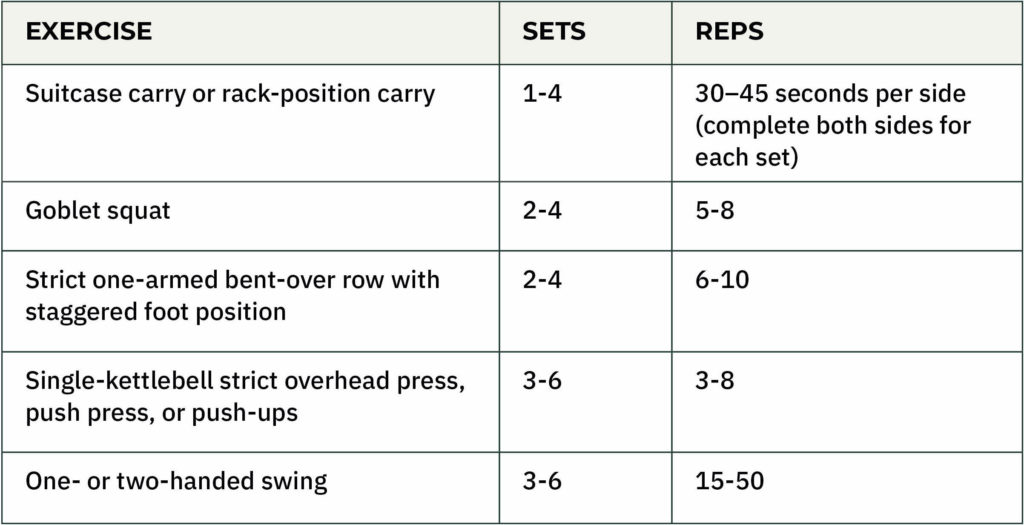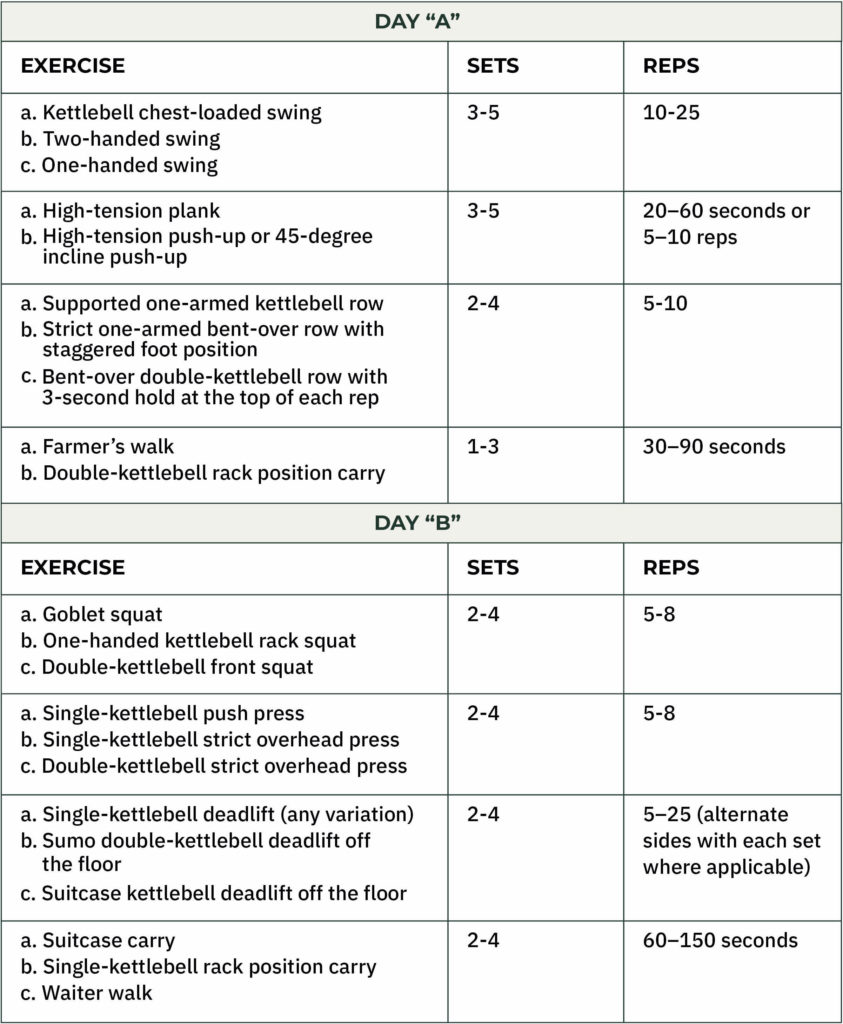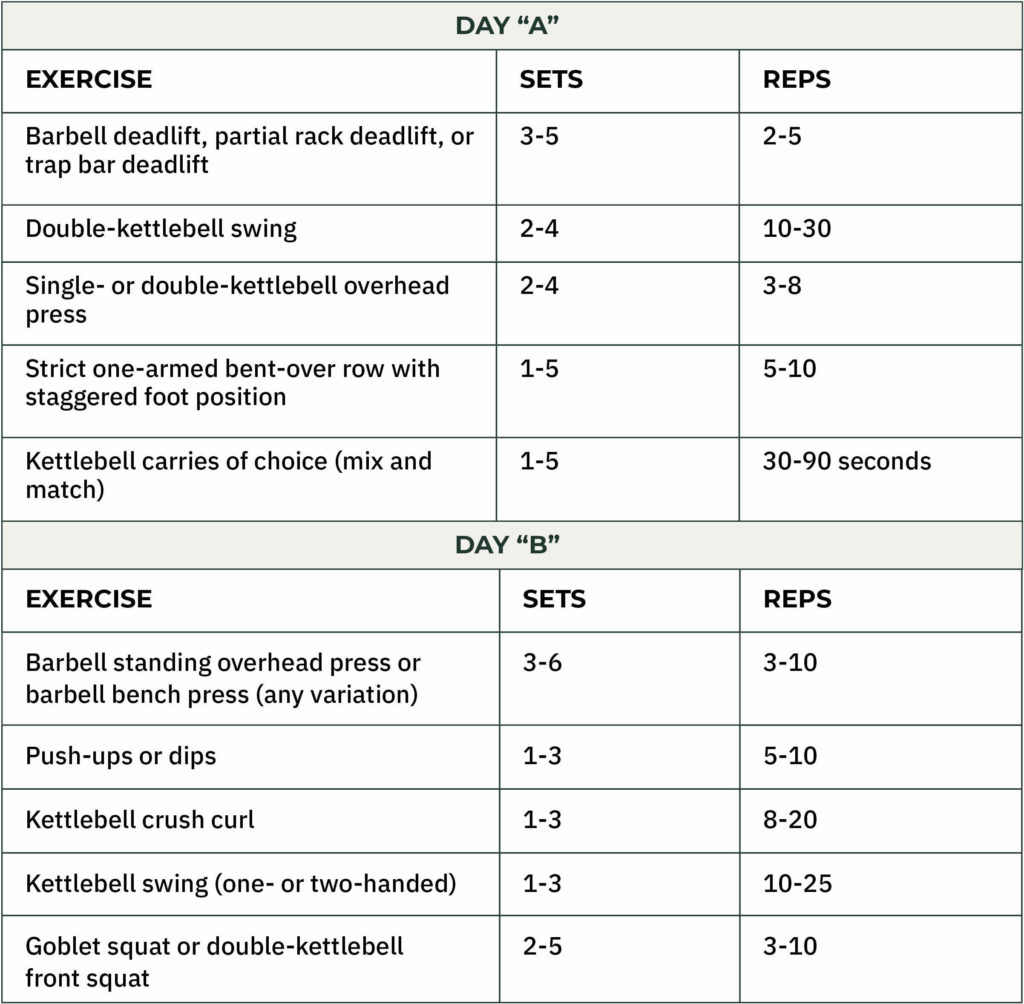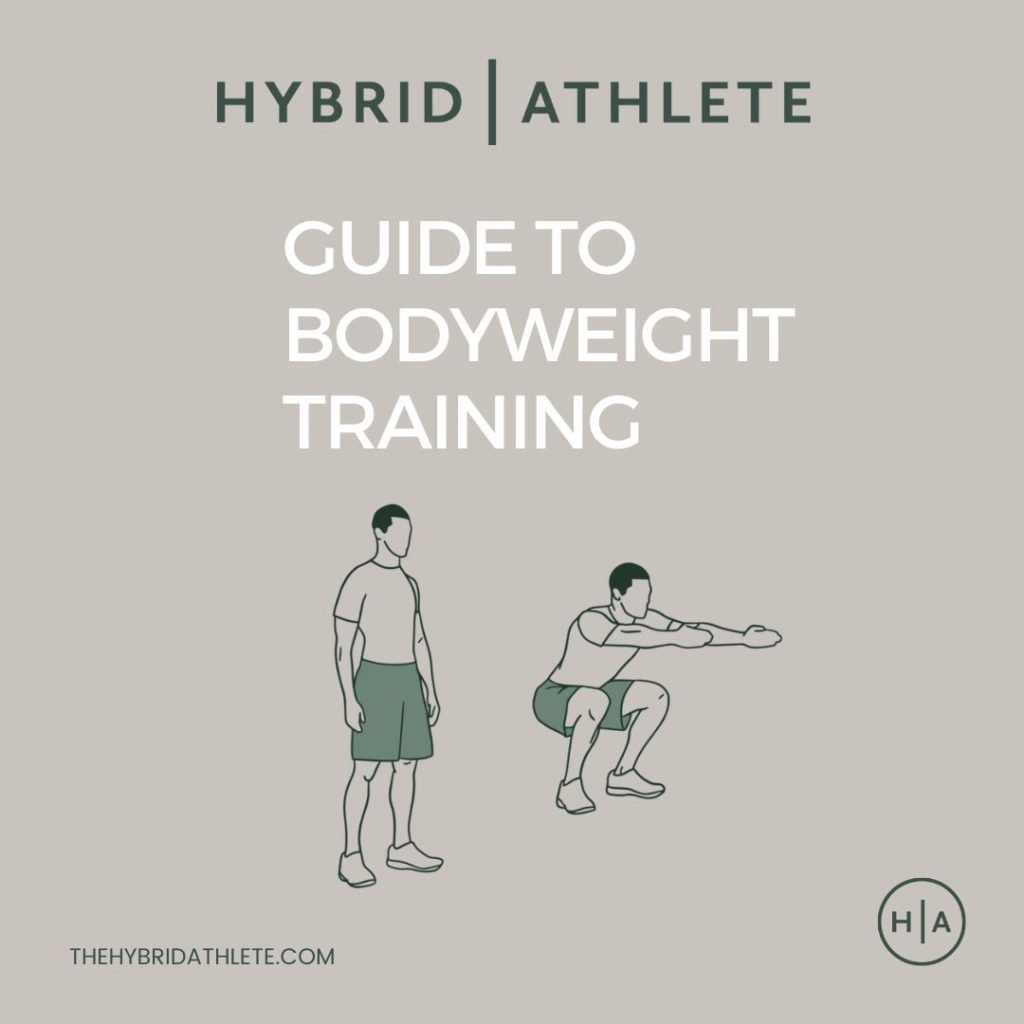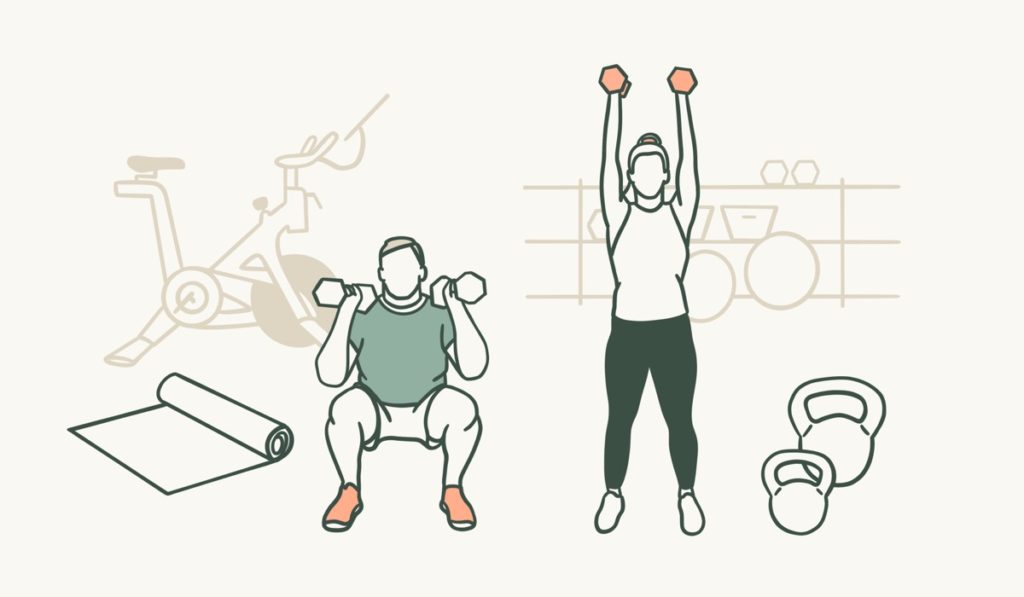We believe fitness is fundamentally simple, and few pieces of training equipment are simpler than a kettlebell. Perfectly situated at the intersection of strength, endurance, and functional movement, kettlebell training can be for everyone.
Whether you’re new to kettlebells, new to strength training altogether, or an experienced lifter, this guide is designed to provide you with the foundational knowledge you need to use kettlebells for increasing strength, improving muscular endurance, and building lean muscle.
Keep reading to learn the basics of kettlebell training, benefits and downsides, tips to get started, common kettlebell movements to know, three different kettlebell-based training programs, and much more.
What is Kettlebell Training?
Kettlebell training is similar to other types of strength training, except it uses a special type of handheld free weight called a kettlebell. Kettlebells are constructed differently from the common types of free weights most people are familiar with (like dumbbells and barbells).
High-quality kettlebells are balls made of solid iron or steel that range anywhere from about five pounds up to 150–200 pounds or higher. A handle of the same material is forged on top.
If you’re new to kettlebell training, the ideal weight for a kettlebell is likely somewhere between 10–25% of your body weight depending on your current strength levels (we’ll get into this more later in the guide).
Compared to dumbbells, the thicker handle and uneven weight distribution of a kettlebell not only require changes to your technique during conventional movements but also allow for totally new movement variations compared to other types of equipment.
Most kettlebell movements are fluid, explosive, compound movements that are safe to perform for higher repetitions. For example, the kettlebell swing is a dynamic hip hinge movement that recruits muscles in the upper body as well as the lower body.
If you’ve never handled a kettlebell before, your first reaction might be to wonder whether they’re legitimately different (or better) than other types of equipment, or just a gimmick.
The truth is that kettlebells are definitely better for some movements (such as swings) and effectively similar for others, often becoming a matter of preference.
But above all, they’re undeniably different, and that makes them a fun and valuable addition to your training toolbox.
Along with the basic mechanical differences in how a kettlebell feels and handles, most people also train differently with kettlebells in the following ways:
- Full-body training rather than upper/lower or body part split programs
- More focus on compound movements, with few to no “isolation” lifts
- Increased attention to technical aspects of form
- More explosive, dynamic, and ballistic exercises
- Higher overall volume (per set and per exercise)
In the next section, you’ll learn more about the unique benefits and downsides of training with kettlebells.
The Benefits and Downsides of Kettlebell Training
Downsides
First of all, kettlebells don’t allow you to adjust the weight up or down with weight plates. The weights are fixed, so you’ll need a separate kettlebell for each desired weight.
You can still add reps or use other progression methods, but if you’re looking to add strength with only kettlebells, you’ll want to consider buying heavier kettlebells to support your training goals.
Barbells, however, may be the better choice if you want to go extremely heavy or add weight frequently.
The other potential downside is that kettlebell-specific movements are somewhat technical. The complex nature of some kettlebell movements can be a recipe for problems if you rush into it. So, like starting out with other free weight training, you might need mentoring or coaching (even over video, if that’s your only option) to get the form down. And always make sure you understand and rehearse the form of any movement before you go heavy or push yourself.
Next, we’ll take a closer look at the benefits of kettlebell training.
Simple, Portable, and Robust
The simplicity of the equipment is one of the main attractions for people who love kettlebell training.
Not only are kettlebells themselves an extremely simple tool, but kettlebell training also has a gritty, raw, fundamental appeal that’s different from complex, high-end equipment or chromed-out commercial gyms.
Kettlebell training cuts through a lot of unnecessary methods and accessories. Think of it as an invitation to get back to basics and focus on what matters in your training: the exercise, not the extras.
They’re also portable and virtually indestructible. You can toss one or two kettlebells in your trunk or truck bed and go enjoy a session on a mountain, in a forest, at the beach, or wherever you want.
Versatile and Cost-Effective
Kettlebells are, arguably, the single most versatile piece of exercise equipment on the planet.
When people say that kettlebells can “replace an entire gym,” that’s not an exaggeration.
You can do any compound movement you could do with a barbell or dumbbells, plus other movements that are exclusive to kettlebells.
The versatility of kettlebells also makes them incredibly cost-effective compared to other types of strength training equipment, not to mention space-saving.
Kettlebell Training is Time-Efficient
Because kettlebell training builds multiple types of fitness at once, it’s also time-efficient.
Performing several different explosive kettlebell exercises back to back with minimal rest can build these qualities simultaneously:
- Strength
- Power and speed
- Muscular endurance
- Power endurance (the ability to generate high levels of force and maintain explosiveness for prolonged periods of time)
- Aerobic fitness
Kettlebells Build Real-World Strength
In real-life situations outside of the gym, your grip strength can be a limiting factor, and real-world objects are rarely perfectly balanced or designed for easy lifting.
The point being, unlike most conventional weights, kettlebells can help prepare your body for these differences because they’ve got thicker handles and are unevenly weighted.
Also, the fluid, arcing motion of many kettlebell exercises may be more realistic (or “functional”) compared to the perfectly aligned, straight-up-and-down path of barbell and dumbbell movements.
Kettlebell Training is Great for Your Back
Several studies suggest that kettlebell training can reduce pain in the neck, shoulders, and lower back as well as decrease pain sensitivity for the lower back.
According to world-renowned back health expert Dr. Stuart McGill, “rapid muscle activation-relaxation cycles” and the unusual type of lumbar spinal loading that occurs during kettlebell swings could be responsible for the unique back health benefits.
While you should still use caution, especially if you have a history of back problems, kettlebell training may be helpful in rehabilitating or preventing back injuries.
Getting Started With Kettlebell Training
Select the Correct Kettlebell Weight
If you’re training at a facility that provides kettlebells, you’ll have a range of weights to choose from.
Here are two guidelines to follow that can make the decision easy:
- If you’ve only used dumbbells before, choose a kettlebell that is 10–15 pounds lighter than your dumbbell equivalent at first.
- Choose a kettlebell that allows you to perform five or more repetitions of a given exercise.
The offset weight and thicker grip require different form and recruit different muscles, so start relatively light and don’t go any heavier until you’re confident in your technique.
In fact, traditional kettlebell training emphasizes mastering form, then increasing volume, and only then increasing weight. Form and volume will always come before bumping up weight.
If you’re training at home, you can start exercising with one or two kettlebells in your collection and consider branching out later on as you get stronger.
Here are some loading suggestions if you’re purchasing kettlebells for home use:
- Active women of average strength can start with a 20-pound kettlebell, or both a 10-pound and 20-pound kettlebell for versatility.
- Physically fit women of above-average strength can start with a 35-pound kettlebell, or work in both 15-pound and 35-pound kettlebells.
- Active men of average strength can start with a 35-pound kettlebell, or both a 20-pound and 35-pound kettlebell for versatility.
- Physically fit men of above-average strength can start with a 50-pound kettlebell, or work in 35-pound and 50-pound kettlebells.
In the case of dual options, the heavier kettlebell is for lower-body movements, and the lighter kettlebell is primarily for upper-body movements.
Once you get stronger, you can progress to using the heavier kettlebell for upper-body movements, then buy an even heavier kettlebell for your lower body or a second kettlebell of the same (heavier) weight to perform lower-body movements with two kettlebells.
Avoid Low-Quality Kettlebells
Low-quality kettlebells may be inexpensive, but if you’re planning to make a kettlebell routine a regular or lifelong endeavor, it pays to seek out the sturdy sort.
Quality is relative, but generally, subpar kettlebells don’t last as well as those from trusted equipment makers, they tend to handle poorly, and they’ve got other downsides that will detract from your future workouts.
If you’re buying your own kettlebell to use at home, here’s what to look for:
- Cast iron or steel construction, not plastic and cement or other materials
- Enough clearance for your hand and knuckles to fit between the handle and the bell
- A large, curved handle that you can grip with two hands
- A durable, relatively smooth finish that allows the handle to rotate comfortably in your palms
Decent-quality, durable-metal kettlebells start around $40–50 and go up from there depending on size and brand (don’t forget to look at shipping cost, too—free shipping is worth a lot with the bulk weight of kettlebells).
When you consider getting a lifetime of use for less than $100, it really makes sense to buy kettlebells of reasonable quality.
Form > Volume > Loading
Briefly aforementioned, the underlying philosophy for kettlebell training is to focus on movement quality, first and foremost, before adding lots of reps or going heavy.
You should always view every workout as an opportunity to pay attention to your form.
If you’ve never tried a movement before, or you’re unsure of the correct form, watch videos and, if possible, get feedback on your execution.
Here are some general tips on kettlebell form to keep in mind:
- Root your feet. Maintain awareness of your feet on the ground, and make sure your heel, ball, and outer portion of the front of your foot are all in contact with the ground and bearing weight evenly (front to back and side to side).
- Squeeze your glutes and abs. Especially on grinding exercises (slow, controlled movements in the kettlebell world), squeezing your abs and glutes helps you move heavy weights safely. Tensing these muscles while temporarily holding your breath makes for an extremely stable spine and torso.
- Control your breath. During the most challenging part of a rep, either hold a big breath in or breathe outward against pursed lips. Only breathe inward during the easy part of reps, or in-between reps.
- Neutral spine, “big” chest, level chin. Instead of rounding your lower back, keep it neutral or slightly arched to protect your spine. And stick your chest out with your shoulders down low (or “packed”) and slightly retracted to lengthen your spine and protect your shoulders. Do all of this while keeping your head flat and chin level to protect your neck.
- Grip hard. Gripping kettlebells harder to increase tension can help recruit more muscles throughout your body, which can help you perform more reps or lift more weight. If you feel like you’re struggling to complete reps, try gripping harder.
Think of strength as a skill. And like any skill, the fundamentals of being strong require plenty of practice.
When you’ve built the physical awareness to follow these cues and have honed your form on all the fundamental exercises, you’ll be ready to add more volume.
And when you can maintain excellent form with high workout volume, you’ll be ready to move up to a heavier kettlebell. A simple progression.
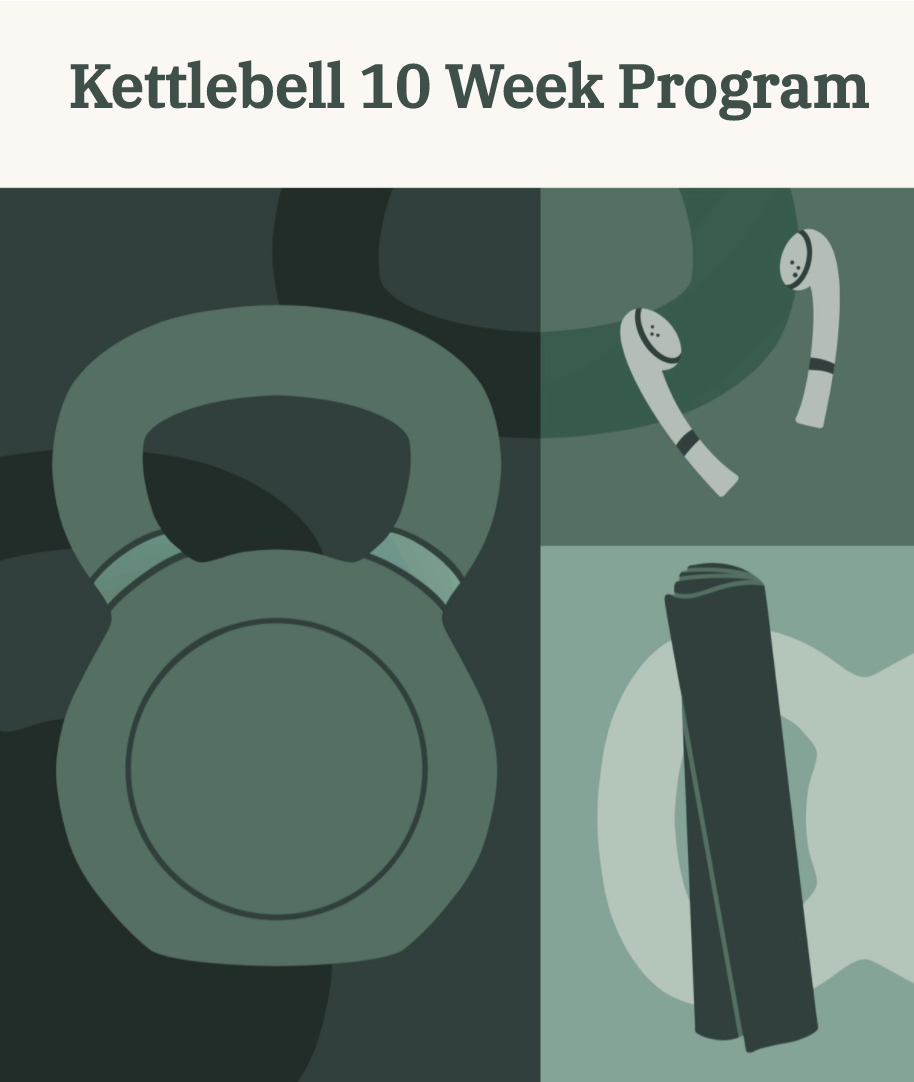 Kettlebell 10 Week Program
Kettlebell 10 Week Program
- 10-week program: 3 workouts each week for the first 4 weeks, then 4 workouts each week for the last 6 weeks
- 25-60 minutes per workout
- Requires at least one kettlebell in the range of 15lb to 25lb.
- Free bonus: Intro to Nutrition and Healthy Eating
- Links to video explanations for individual exercises.
- Mobile and Desktop versions available
- Printable PDF workout calendar
Kettlebell Training for Different Goals
Kettlebell training is a methodology that can be applied to a wide range of program protocols. Their versatility, simplicity, and unconventional design make them like a Swiss army knife, applicable to strength training, functional movement, endurance training, and more.
From CrossFit to rock climbing, kettlebells have become a popular and timeless tool for hitting your goals. Let’s take a look at a few common programs.
Kettlebells for Strength
Like other types of free weights, kettlebells are a top-notch strength training tool.
Research shows that strength training builds lean muscle, improves physical performance and movement control, and even boosts cognitive abilities and self-esteem.
As we’ve already mentioned, because kettlebells are fixed weights, they don’t allow for adding weight easily like a barbell.
To make up for the lack of adjustability, you can either buy multiple kettlebells of different weights to allow for progression, or shift your training focus from easier to more challenging movements over time (we cover this in the Common Kettlebell Movements to Know section below).
Compound kettlebell movements are excellent for getting stronger. Choose a weight that’s challenging in the 1–5 rep range. Then, lift as explosively as possible while continuing to grind out reps until you notice a decline in form, then stop and rest before performing more reps.
Kettlebells for Functional Movement Training
Functional training is similar to pure strength training, but with more emphasis on the ability to use your strength outside the gym. This type of training also emphasizes movement quality, injury prevention, and versatility. Think of the goal as achieving peak performance for everyday life—like sprinting down the street or carrying a TV up the stairs with ease.
Kettlebells are well-suited to functional training because of their offset center of gravity and the fact that they allow for one-handed (asymmetrical) movements.
If you want to be more functional, try full-body kettlebell workouts with a variety of rep ranges and extra emphasis on loaded carries and one-handed exercises.
The “Cook Drill” and “Armor-Building Complex” from the Kettlebell Finishers section of this guide are also perfect for increasing your functional movement proficiency.
Kettlebells for Power Endurance
Power endurance is the ability to generate explosive power for prolonged durations. A great application of power endurance is in rock climbing, where you must be both strong and conditioned.
To train power endurance, you need movements that are:
- Explosive in nature
- Conducive to performing high reps
- Low-risk and relatively safe when you become fatigued
For those reasons, kettlebell swings (all varieties) are among the best choices for building power endurance.
If you’re new to swings, start with the two-handed, single-kettlebell variety and incorporate multiple sets of 15–50 reps per set each workout for an instant power endurance boost.
The “Swing Finisher” and “Litvisprint Finisher” under the Kettlebell Finishers section, below, are also excellent choices for power endurance.
Common Kettlebell Movements to Know
If you’re new to kettlebell training, you can use this list to familiarize yourself with cues for the most common kettlebell exercises and better understand the programs in the next section.
But remember that learning and mastering form is a long-term process, so make sure to study as much as necessary until you feel 100% confident in your knowledge.
The movements below are organized according to the five fundamental human movements (push, pull, squat, hinge, loaded carry), then listed in descending order from most basic to most challenging.
Strict Overhead Press
Press one or two kettlebells upwards from the rack position (shoulder height) to straight overhead while standing.
Push Press
Start in the rack position like a strict overhead press, but at the beginning of the movement, dip to achieve a small amount of knee and hip bend, then drive (or push) through your lower body explosively (as if you were trying to jump) to assist with locking the kettlebells overhead.
Thruster
With a shoulder-width stance or wider, hold two kettlebells in the rack position at chest height, bend your knees and hips to squat as low as you can go while maintaining balance and a straight back. Then, drive through the lower body explosively as you push weights overhead until arms are fully extended before reversing through the motion to complete the rep. This is commonly performed with one kettlebell as well. In this case, you’ll use both hands to hold one kettlebell at chest height.
Bent-over Row
Begin in a bent-over position with your torso nearly parallel to the ground, holding one or two kettlebells in front of your body with your arm(s) straight. Begin by rowing (pulling) the kettlebell(s) from the starting position near the floor towards your torso, then lower back down to finish the repetition.
Crush Curl
While standing upright, hold a kettlebell by the rounded bell (not the handle) in front of your body, down by your hips. Bend your arms to raise the kettlebell up to your chest, then flex your elbows to lower back down to finish the rep. Hint: Chalked hands reduce the risk of accidentally dropping your kettlebell.
Goblet Squat
With a shoulder-width stance or wider, hold a kettlebell at chest-height by the “horns,” or vertical part of the handle on either side, with thumb-side up. Bend your hips and knees to squat back as low as you can go while maintaining balance and a straight back, then reverse to the starting position. To pry (optional), rest at the bottom and maintain tension in your torso as you focus on stretching and opening up your hips and ankles with pressure from your elbows.
Kettlebell Front Squat
With a shoulder-width stance or wider, using two hands, hold the kettlebell by the handle at chest height, bend your knees and hips to squat as low as you can go while maintaining balance and a straight back, then revert back to the starting position.
Sumo-stance Deadlift
With your feet set wider than shoulder-width apart and knees slightly bent, sit your butt back and hinge forward at the hips and pick the kettlebell up off the ground from between your legs with one or two hands. Keeping your back straight, drive through your feet and hips until you’re standing upright, then revert to the starting position.
Romanian Deadlift
Start by holding one or two kettlebells at hip height, then drive your hips back with knees soft (neither bending much nor fully locked out) until you feel a stretch in your hamstrings and can’t go back any farther, then squeeze your glutes, extend your hips, and return to the starting position.
One-handed Swing
Performed like the two-handed swing but while gripping a single kettlebell with only one hand. You can make a fist with your inactive hand and hold it against your torso at sternum level. Focus on keeping your shoulders horizontal and preventing your torso from twisting as you swing.
Two-handed Swing
With your feet shoulder-width or wider, hold a kettlebell between your legs with both hands. Hinge back, then thrust your hips forward to raise the kettlebell dynamically in front of you, as high as shoulder or eye level. The kettlebell should follow a pendulum-like arc. When you reach the top, actively pull it back down by engaging your abs and lats. Maintain full control and balance during the entire repetition, and explode back up when you get to the starting position.
Chest-loaded Swing
With your feet slightly less than shoulder-width apart, hold your kettlebell by its horns at the height of your lower sternum and pull the body of the kettlebell into your torso. Hinge (bend) your hips back, keeping your back straight, with your knees “soft” (neither bending much nor fully locked out) until you can’t hinge any further back, then squeeze your glutes and reverse to the upright starting position.
Double-kettlebell Swing
With your feet wider than shoulder-width, hold a kettlebell in each hand between your legs. Hinge back, then thrust your hips to raise the kettlebells dynamically in front of you, as high as shoulder or eye level. The kettlebells should follow a pendulum-like arc. When you reach the top, actively pull them back down by engaging your abs and lats. Maintain full control and balance during the entire repetition, and explode back up when you get to the starting position.
Suitcase Deadlift
With a shoulder-width stance and a kettlebell outside your stance to the left or right of one of your feet, hinge your hips, grip the kettlebell with one hand, and stand up, then lower back to the starting position.
Kettlebell Clean
Standing upright and holding a kettlebell in front of you, out and between legs, bend at your hips to initiate a hip hinge and drive explosively through your feet and hips similar to a swing. At the same time, raise the kettlebell in front of your body (keeping it close at all times) as you maintain your grip, bend the elbows and allow the kettlebell to rotate in midair, finally catching it in the rack position.
Russian Twist
Seated with your knees slightly bent, heels contacting the ground, and core engaged, grip a single kettlebell by the horns. Lean your upper torso back to make a 45-degree angle with the floor, ensuring your back doesn’t bow or arch. Twist your trunk and lightly tap the base of the kettlebell on the floor beside your right hip, then twist the other way to repeat on the left.
Farmer’s Walk
With an upright posture and holding one kettlebell in each hand by your sides, walk forward as smoothly as possible.
Suitcase Carry
With an upright posture and holding one kettlebell in only one hand by your side, walk forward as smoothly as possible.
Rack-position Carry
With an upright posture, holding one or two kettlebells in the rack position at shoulder height, walk forward as smoothly as possible.
Waiter Walk
With an upright posture, hold one kettlebell by the handle in a locked out and stable overhead position, walk forward as smoothly as possible.
Incorporating Kettlebell Training: Sample Programs
Kettlebell Warm-Up
Use this kettlebell-based warm-up to increase mobility, activate your posterior chain, and prepare your body for strength training or other activities.
You can also add 1–4 sets of 3–10 reps of push-ups or kettlebell presses of your choice to make it a full-body, active recovery workout.
**Prying refers to using your elbows to apply pressure to the inside of your knees in a deep squatting position, thereby stretching the adductor (groin) muscles.
Hybrid Athlete Single-Kettlebell Workout
If you own a single kettlebell or want to try kettlebell training once per week along with your current program, this full-body workout is the perfect starting point.
Hybrid Athlete Progressive Beginner Kettlebell Program
This workout relies on progressing through increasingly challenging movements rather than adding reps or volume.
Stay with the first individual movement variation (“a”) for one to two weeks minimum, or as long as necessary until you’ve gotten a solid grasp of it. Then, move onto the next variation (“b, then c”).
When you’ve gone through all the movement variations, start back at the beginning with more weight or higher volume, or move on to another training program.
Hybrid Athlete Barbell and Kettlebell Novice Program
These workouts combine the advantages of barbells and kettlebells for the best of strength and functional training worlds. The primary mode of progression should be adding weight or volume to the barbell movements, while secondarily adding some volume to kettlebell exercises when possible.
If you get stalled, try switching out to “similar but different” variations of your chosen barbell movements.
Kettlebell Finishers
Use these kettlebell finishers at the end of any workout for a strength and conditioning boost. Combine them with the other kettlebell workouts listed above, add them onto your current training sessions, or even try them as standalone workouts.
Swing Finisher: For a total of 12 minutes, alternate between 30 seconds of swings and 30 seconds of active rest (such as walking).
“Cook Drill” (from physical therapist and sports medicine veteran Gray Cook): With one kettlebell, starting on your non-dominant side, press the kettlebell once and perform a waiter walk until the kettlebell wobbles or you struggle to keep your spine locked in a straight position. Lower the kettlebell to the rack position, then perform a rack carry until the kettlebell wobbles or you experience difficulty keeping your spine aligned (leaning to one side). Lower the kettlebell to your side, then perform a suitcase carry until you’re no longer able to continue with good form. Repeat the entire process on the other (dominant) side of your body. The goal is to eventually perform the Cook Drill nonstop for a total of 15 minutes.
Litvisprint Finisher: Double-kettlebell swing for 20–30 reps or double-kettlebell front squats for 5–10 reps, followed by hill sprints or bounding up stairs. Walk down, rest 30–60 seconds, and repeat the sequence for a total of 3–5 sets.
Dan John’s “Armor-Building” Complex or “Inner Tube” Complex: With two kettlebells, perform at least one round of two double-kettlebell hang cleans, one double-kettlebell press, and three double-kettlebell front squats in sequence, meaning without setting down the kettlebells. Repeat for multiple rounds, resting as needed between rounds (if you have a training partner, try “I go, you go”). For an added challenge, try farmer’s walks or rack carries between rounds.
Takeaway
Kettlebells are affordable, portable, and require minimal space.
They’re excellent tools for anyone to get stronger, and kettlebell training is also a time-efficient way to develop multiple fitness qualities at once.
If you keep kettlebells at home, there’s no need to ever miss a workout again—but you might need some extra time off if you dive in too fast, so be sure to ease in if you’re new.
Need more know-how before your first kettlebell swing? We strip exercise down to the basics with our Bodyweight Training Guide and build it up with our Strength Training Guide. If you’re ready to start a kettlebell program, check out our Kettlebell 10 Weeks Training Plan.
 Kettlebell 10 Week Program
Kettlebell 10 Week Program
- 10-week program: 3 workouts each week for the first 4 weeks, then 4 workouts each week for the last 6 weeks
- 25-60 minutes per workout
- Requires at least one kettlebell in the range of 15lb to 25lb.
- Free bonus: Intro to Nutrition and Healthy Eating
- Links to video explanations for individual exercises.
- Mobile and Desktop versions available
- Printable PDF workout calendar

